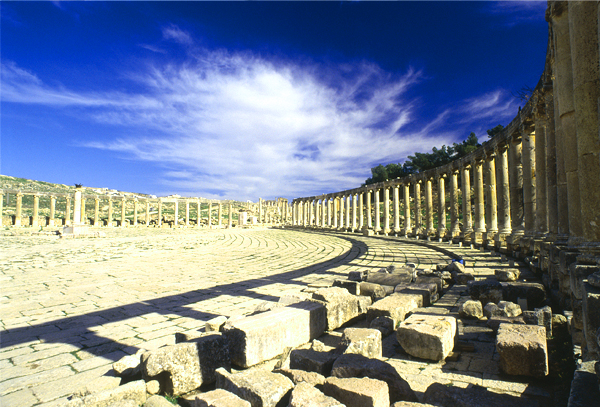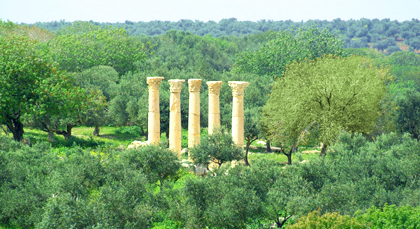Jordan History
Anyone interested in Jordan should have at least a basic knowledge of its amazing history; for much of Jordan’s labor force, GDP, city planning, and transportation system is organized around preserving and celebrating its memory.

Jordan’s history may be conveniently divided into three main periods,
each of which is significant to the situation of Jordan today. First, is the period from the first prehistoric settlements in the Fertile Crescent to 1516, during which the great cities of Jordan’s past grew up along major trade and pilgrimage routes that passed through Jordan.
The second period consists of almost exactly four centuries between 1516, by which time the trade routes that supported Jordan’s cities had declined, and 1916. The third period begins with the proclamation of the Great Arab Revolt of 1916 against the Ottoman Empire from which date almost all of the developments of modern independent state of Jordan.
The significance of the first period of Jordan’s history is that all of the cultures and civilizations that constitute the historical heritage of Jordan, and of which Jordan is the cultural and religious custodian (and all the ruins of the great cities and archeological sites which attract thousands of tourists to Jordan every year, and account for much of Jordan’s modern economy) date from this period.
anyone interested in Jordan should have at least a basic knowledge of this period; for much of Jordan’s labor force, GDP, city planning, and transportation
system is organized around preserving and celebrating its memory..
Therefore, anyone interested in Jordan should have at least a basic knowledge of this period; for much of Jordan’s labor force, GDP, city planning, and transportation
system is organized around preserving and celebrating its memory.
First Period—The Age of the Great Cities and Civilizations of Antiquity and the Middle Ages
Numerous peoples, cultures, and civilizations have settled, ruled, or influenced the region of Jordan since the prehistoric birth of civilization in the Fertile Crescent. These include the Canaanites, Moabites, Assyrians, Babylonians, and Persians. At various times in antiquity Jordan was ruled by the Pharoahs of Egypt and the Judean Kingdom. During Hellenistic and Roman times, Jordan gave birth to the famous Nabataean civilization which left its mark in Petra, one of the Seven Wonders of the World.
 Jordan also boasted of several great and rich cities during antiquity, the greatest of which, besides Petra, were part of the famous Decapolos League. These included Philadelphia (Amman), Gerasa (Jerash), Gadara (Umm Qais), Pella and Arbila (Irbid), which have left many ruins that attract tourists today.
Jordan also boasted of several great and rich cities during antiquity, the greatest of which, besides Petra, were part of the famous Decapolos League. These included Philadelphia (Amman), Gerasa (Jerash), Gadara (Umm Qais), Pella and Arbila (Irbid), which have left many ruins that attract tourists today.
By the second century C.E., Jordan was part of the Roman province of Arabia. The Emperor Hadrian completed the Via Nova Traiana, a Roman road connecting Syria to the Gulf of Aqaba. During this period the peoples and cities in Jordan reached levels of unprecedented prosperity.
By 636 Muslims conquered the area of Jordan from the Byzantine Empire and ruled from Damascus, which resulted in many roads, and much trade and travel through Jordan to Jerusalem and Mecca to the west and south, and Baghdad to the east.
Later in the Middle Ages, the Crusader Kingdom of Jerusalem wrestled control over Jordan and built a line of strongholds along trade and pilgrimage routes. In 1187, Saladin liberated Jordan from the Crusaders and moved his capital to Cairo. But his Mamluk successors ruled from Damascus.
All of these civilizations, empires, cities, and peoples are relevant today primarily for the ruins they left behind, which enrich Jordan by the memories they evoke and the tourists they attract.
Second Period of Jordan History—The Age of Depopulation
The second period of Jordan’s history is exactly four centuries long, dating from approximately 1516 to 1916. This period is characterized by the large scale depopulation of Jordan and abandonment of most of its formerly thriving cities. 
This phenomenon was caused by two independent developments that just happened to coincide.
The first is that most of the trade and pilgrimage routes that formerly passed through Jordan were replaced by other routes, including new and cheaper sea routes. The second was that with the Ottoman conquest in 1516, Damascus ceased to be major site of imperial control whose communication, trade, and pilgrimage routes passed through Jordan. With the Ottomans ruling from Constantinople, their imperial routes of trade and control now ran around Jordan.
For the next four centuries, therefore, there was little trade passing through Jordan to support the cities located along the former routes. Most inhabitants of the area of Jordan had to emigrate to elsewhere in the empire.
With the decline of the cities, most of the remaining inhabitants reverted to rural agricultural life in the fertile western areas along the Jordan, while those in the mountains and eastern desert reverted to nomadic life.
Amman at the end of the 19th century had been reduced to only a small settlement with a population of fewer than 3000 inhabitants.
It was because Jordan was so depopulated that knowledge of the great ruins at Petra remained unknown to the world for centuries, until a British explorer rediscovered them in 1812. For the same reason, Amman at the end of the 19th century had been reduced to only a small settlement with a population of fewer than 3000 inhabitants.
It was not until 1910, upon the completion of a new railway built by the Turks to connect their armies in Aqaba and throughout the region that Amman was once again on a trade and travel route, and began to grow again. 
Thus throughout the 19th and early 20th century, the present day area of Jordan was administratively designated as “Transjordan”—a term that conveyed no more content than “the unknown land on the other side of the Jordan River,” whose inhabitants were collectively simply known as Bedu or Bedouins—a term meaning simply “desert dwellers.”
This period of depopulation is especially important today because Jordan was so empty in this period that several peoples escaping persecution in foreign countries sought refuge by immigrating to Jordan. This includes the current population of Chechins in Jordan who began arriving in the mid-19th century from southern Russia and the Caucasus.
Similarly, between 1.25 and 2 million Circassians were forced from their homes in the Caucasus and had to seek a new place to live. Most died in their people’s wanderings. Some settled in the Balkans, while others made it to the Levant. It is estimated that 80,000 made it into the Ottoman Empire, whose officials sent them in waves to settle in Jordan beginning in 1878. Estimates of the Circassian population in Jordan today range from 20,000 to 80,000.
(Because of recent news reports about women’s rights groups objecting to the custom of seizing brides by force, it is worth noting that this was originally brought to Jordan as a Circassian custom.)
Thus, this second period of Jordanian history is relevant today for four reasons. First, it demonstrates a fundamental principle governing all development in Jordan throughout is history, namely that Jordan can only succeed economically as part of international trade. Second, it explains why the Chechen and Circassian population of present-day Jordan came to be here. 
Third, it establishes that Israel is not the only country in the Middle East that has been a refuge of peoples from persecution elsewhere. Finally, it helps explain why Jordanians have been so welcoming to the victims and refugees of its war-torn neighbors, such as Palestinians and Iraqis.